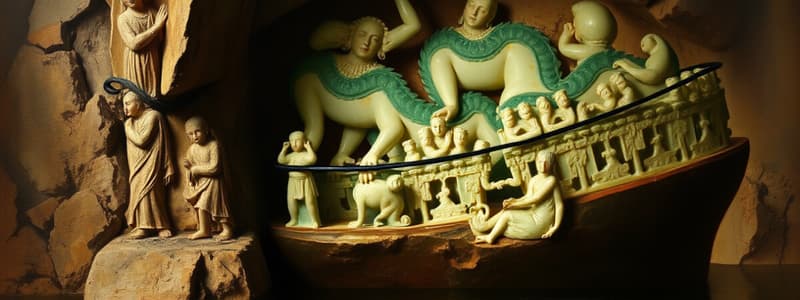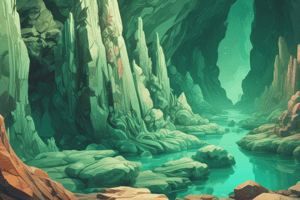Podcast
Questions and Answers
What is the significance of the square and round shapes in the jade cong?
What is the significance of the square and round shapes in the jade cong?
- Square symbolizes the earth, round symbolizes the heavens. (correct)
- They are purely decorative.
- They depict animal forms.
- They represent different civilizations.
Which of the following materials was used in the creation of the Apollo 11 rock art?
Which of the following materials was used in the creation of the Apollo 11 rock art?
- Charcoal on quartzite (correct)
- Acrylic on canvas
- Charcoal on limestone
- Stone and clay
What is the main context in which the Great Hall of the Bulls exists?
What is the main context in which the Great Hall of the Bulls exists?
- In a rural village gathering space.
- In an ancient temple for worship.
- In a prehistoric cave with energy-filled animals. (correct)
- In a modern gallery setting.
What function is suggested for the cave paintings like those found in Apollo 11?
What function is suggested for the cave paintings like those found in Apollo 11?
What describes the artistic style of the Great Hall of the Bulls?
What describes the artistic style of the Great Hall of the Bulls?
What is a likely function of the Ambum stone?
What is a likely function of the Ambum stone?
Which of the following materials was used to create the Tlatilco female figure?
Which of the following materials was used to create the Tlatilco female figure?
What characteristic is notable in the depiction of the running horned woman?
What characteristic is notable in the depiction of the running horned woman?
What date range is associated with the construction of Stonehenge?
What date range is associated with the construction of Stonehenge?
Which feature best describes the Terra cotta fragment?
Which feature best describes the Terra cotta fragment?
In what context was the Bushel with ibex motif likely used?
In what context was the Bushel with ibex motif likely used?
What artistic technique was used in the creation of the Lake Texcoco skull/bone piece?
What artistic technique was used in the creation of the Lake Texcoco skull/bone piece?
What does the Tlatilco female figure symbolize?
What does the Tlatilco female figure symbolize?
What idea is suggested by the communal construction of Stonehenge?
What idea is suggested by the communal construction of Stonehenge?
What period does the running horned woman belong to?
What period does the running horned woman belong to?
Flashcards are hidden until you start studying
Study Notes
Jade Cong
- Dates back to 3300-2200 BCE in Global pre-history, China.
- Originated from Liangzhu, made from true jade/nephrite with patterns created using rubbed sand.
- Found in graves alongside bi discs (donut-shaped).
- Descriptive features include a square shape and hollow tubes.
- Symbolism includes lines and circles potentially representing faces, with ambiguous meanings regarding power, nature, and death.
- Possible interpretations of square (earth) and round (heavens) correlation.
Apollo 11
- Created between 25,500-25,300 BCE in African Rock Art/Global pre-history.
- Located in the Huns Mountains, Namibia; executed in charcoal on brown quartzite stone.
- Likely functioned for ritual ceremonies, supported by skulls found in the area.
- Context involves hunting and gathering nomadic peoples prior to migration.
- Represents figurative/representational art, signifying early behavioral developments.
Great Hall of the Bulls
- Dated between 15,000-13,000 BCE, embodies African Rock Art from the Paleolithic era.
- Originates from Lascaux Cave, Dordogne, France, painted by unknown Lascaux painters.
- Uses natural rock surfaces of smooth white limestone and rougher textures to create a dynamic composition.
- Possibly served narrative or religious functions, akin to ritual purposes seen in other cave paintings.
- Animals depicted in vibrant profiles, suggesting energetic storytelling rather than mere representation.
Camelid Sacrum
- Dates to 14,000-7000 BCE, retrieved in 1870 from Lake Texcoco, central Mexico.
- Crafted from bone, potentially resembling deer or canine skulls.
- May have been used for shamanistic purposes, indicative of human interaction with the animal world.
- Represents a connection to the shamanistic worldview and understanding of animals.
Stonehenge
- Constructed between 3100-2000 BCE, located on Salisbury Plain, England.
- Composed of sarsen stone, bluestone, and wooden posts using tongue and groove and mortise-and-tenon techniques.
- Served as a burial site, calendar, and cultural center, based on animal bones found nearby.
- Implicates communal effort without evidence of slavery and speculates on royal burials, solstice celebrations, or mystical healing practices.
Ambum Stone
- Created around 1500 BCE, originating from Papua New Guinea.
- Made from greywacke stone through chipping and hammering techniques.
- Functions possibly as a ritual object, found in a cave, associated with early Pacific culture.
- Freestanding and detailed, indicating its significance in rituals related to fertility and hunting.
Tlatilco Female Figure
- Dated 1000 BCE from the Tlatilco region in the Valley of Mexico.
- Crafted from clay with incised details, typically found in burial contexts.
- Symbolizes fertility and possibly used as a charm for women, reflecting societal values.
- Notable features include a double head, narrow waist, and broad hips, illustrating concepts of duality.
Terra Cotta Fragment
- Created in 1000 BCE by Lapita peoples during their migrations.
- Made from terracotta and features intricate incisions, possibly part of a large vessel.
- Displays geometric styles with elaborate anthropomorphic faces, marking a significant example of Lapita art.
Running Horned Woman
- Created between 6000-4000 BCE in Tassili n'Ajjer, Algeria.
- Utilizes pigment on rock, possibly representing ritualistic symbols.
- Features long horns and depictions of a warrior figure, with surrounding smaller figures suggesting narrative depth.
Bushel with Ibex Motif
- Dated 4200-3500 BCE, related to Global Pre-History.
- Painted terracotta bushel served as a funerary object connected to the prosperity of the deceased's city.
- Displays large horned goats, resembling Egyptian animals, indicating cultural exchanges and influences.
- Represents the evolution towards Archaic Greek art, offering insights into early artistic traditions.
Studying That Suits You
Use AI to generate personalized quizzes and flashcards to suit your learning preferences.




